
Inside the Story of Retrofitting Roosevelt Landings
A BuildingEnergy Magazine Case Study
In advance of the BuildingEnergy NYC 15 conference on Oct. 15, NESEA gathered insights into one of New York City’s most exciting and innovative projects: the deep energy retrofit of the Roosevelt Landings multifamily building on Roosevelt Island. The retrofit will be featured in a session at the conference.
Three of the primary professionals involved in this retrofit contributed to this article: David Davenport of Urban Greenfit, LLC (UG), Marc Zuluaga of Steven Winter Associates (SWA), and Larry Harmon of Air Barrier Solutions, Inc. (ABS). They have generously provided their reflections, data and insights.
Developing the Leadership and Impact of Roosevelt Landings
The deep energy retrofit of the 1,003-unit multifamily building at the Roosevelt Landings property in New York City demonstrates what can be achieved when owners take the initiative and commit to comprehensive energy retrofits in partnership with a strong development team, building science professionals, and engineers.
Innovative financing was used to implement aggressive air-sealing, smart controls, and distributed generation upgrades that resulted in significant savings even after traditional retrofits had already been completed. This approach resulted in reduced operating costs, improved resident comfort, enhanced resiliency, and exceptional returns to investors.
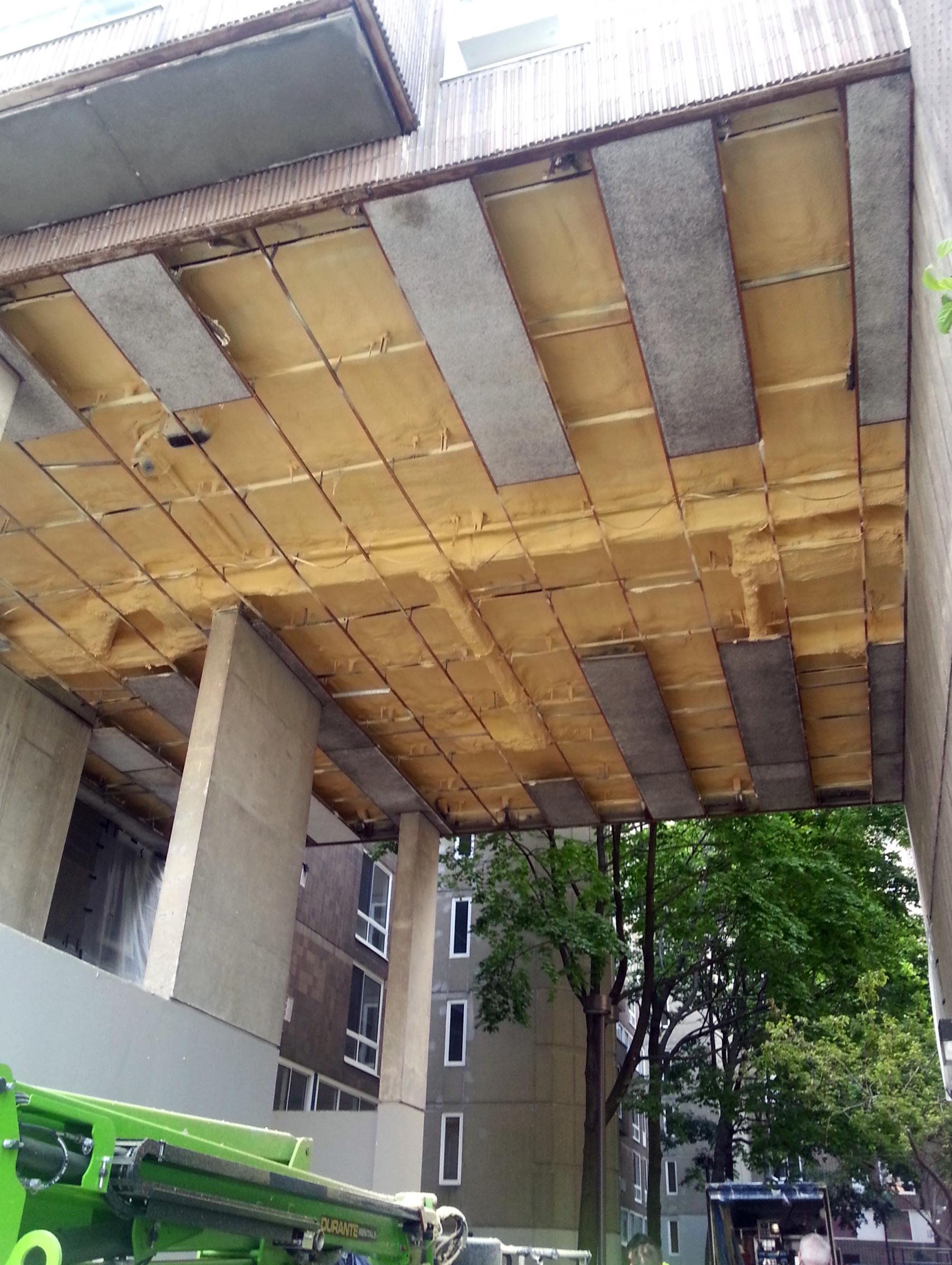 With traditional rebates unable to support the scale of energy-efficiency work that must be done in the future, the project’s most lasting legacy may be its demonstration of the business case for this type of work to hard-nosed investors.
With traditional rebates unable to support the scale of energy-efficiency work that must be done in the future, the project’s most lasting legacy may be its demonstration of the business case for this type of work to hard-nosed investors.
In November 2012, UG closed on the $7.4 million transaction. The project leveraged city, state and federal initiatives to promote renewable energy and energy efficiency in residential housing. It began in January 2013.
At the time of its construction in 1975, critics heralded the innovative design of Roosevelt Landings.
The retrofit was projected to achieve 20 percent new energy savings, reduce grid electricity usage by 15 percent, and create 15 full-time jobs paying Davis-Bacon Act labor rates to all workers during construction. The estimated energy savings were 2,303,416 kWh per year or 6,311 kWh per day, reducing carbon emissions by 750 metric tons of pollutants each year.
This project has outperformed its expectations. To date, it has generated cumulative energy savings of 24 percent – exceeding projections. The project is also outperforming financial goals. The underwritten energy cost savings for the first full year of operation was $571,000. The actual energy cost savings was $708,000 – 124 percent of the projected amount. As of June 2015, the second year of operation, the project had already generated over $515,000 in energy cost savings – 88 percent of the 12-month projection – in its first six months.
This project has outperformed its expectations.
In 2014, the first full year after the retrofit was completed, the net operating income of UG significantly exceeded projections. As a result, UG was able to meet and exceed investor return requirements. Based on a cap rate of 5 percent, the increase in net operating income translates into an increase in building valuation of $19 million.
This increase in building value was achieved with an overall investment of $8 million and the sponsor’s initial out-of-pocket-investment of $1.8 million – a return that any investor should find extremely attractive.
The project was sponsored by Urban American (UA), a real estate investment company that has provided safe, affordable and high-quality apartments for New York City residents for over a decade. Under the leadership of executive vice president Joshua Eisenberg, UA made a strategic decision to lead urban communities in the reduction of carbon emissions with over $10 million in investments in energy efficiency and renewable energy projects to reposition older multifamily housing as sustainable and empower residents as partners.
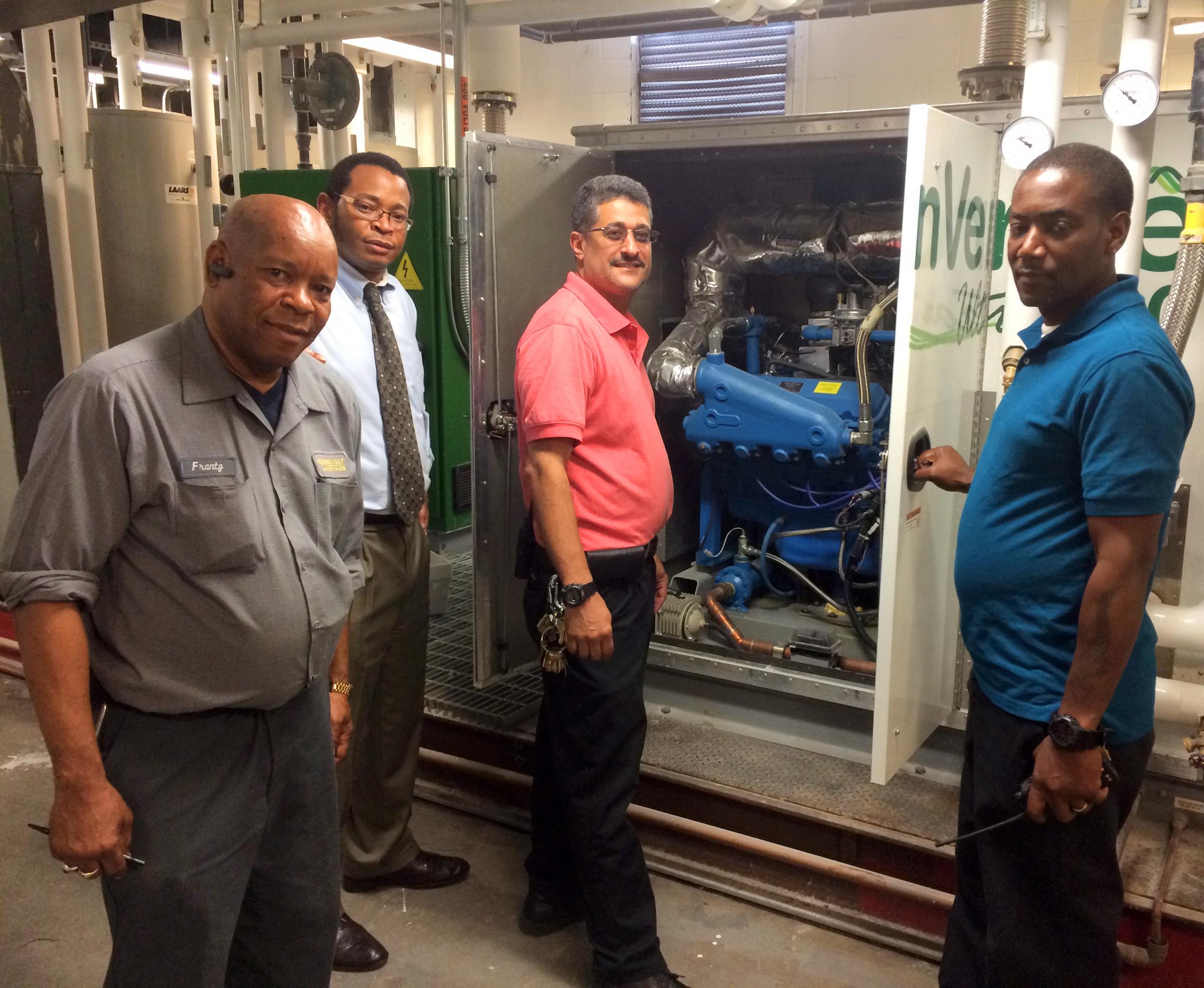 The formation of UG was a direct response to UA’s need to fund improvements to the building without the building taking on additional debt. By creating an off-balance sheet special-purpose investment vehicle that raised the capital and funded the work, UG enabled UA to turn a major capital improvement project into an operating expense. This was achieved through an energy services agreement and power purchase agreement between the building and this new special-purpose investment vehicle. This agreement allowed the building to pay the difference between baseline projections of energy use and the actual energy used after the energy savings. It also allowed the building to pay for the CHP plant.
The formation of UG was a direct response to UA’s need to fund improvements to the building without the building taking on additional debt. By creating an off-balance sheet special-purpose investment vehicle that raised the capital and funded the work, UG enabled UA to turn a major capital improvement project into an operating expense. This was achieved through an energy services agreement and power purchase agreement between the building and this new special-purpose investment vehicle. This agreement allowed the building to pay the difference between baseline projections of energy use and the actual energy used after the energy savings. It also allowed the building to pay for the CHP plant.
This project has set a new precedent, as energy services agreements (ESAs) are more commonly used in the municipal, university, school, hospital and housing authority markets than in privately-owned multifamily buildings.
The project was led by UG and managed by David Davenport. UG conceived the scope of work, structured the financing, and developed the project. The energy-efficiency measures were engineered by a team led by Marc Zuluaga at SWA. The renewable-energy measures were engineered by Stephen Samohous of KGS Buildings and EVCO Mechanical. The principal energy-retrofit work was led by Larry Harmon of ABS and Richard Whiffen of H20 Degree. Legal support was provided by Peter Funk of Funk & Zeifer LLP and Michael Schwamm of Duane Morris LLP. Accounting support was provided by Novogradac & Company LLP.
Improving the Original Design of Roosevelt Landings
At the time of its construction in 1975, critics heralded the innovative design of Roosevelt Landings. Architect Josep Lluis Sert, dean of the Harvard Graduate School of Design, achieved efficiency in space usage by triple-loading corridors with duplex apartments so elevators and public corridors were only needed every three floors.
Unfortunately, since the design was conceived in an era when people thought electricity would soon be too cheap to meter, attention to spatial efficiency did not carry over to the energy-efficiency systems. Heating is provided by electric baseboard heaters. A single electric meter monitors all apartments and residential common areas. Also, residents are not billed separately for the electricity they use.
These shortcomings of the original design saddled the complex with increasingly higher operating costs – a problem UA encountered after it acquired the building in 2007.
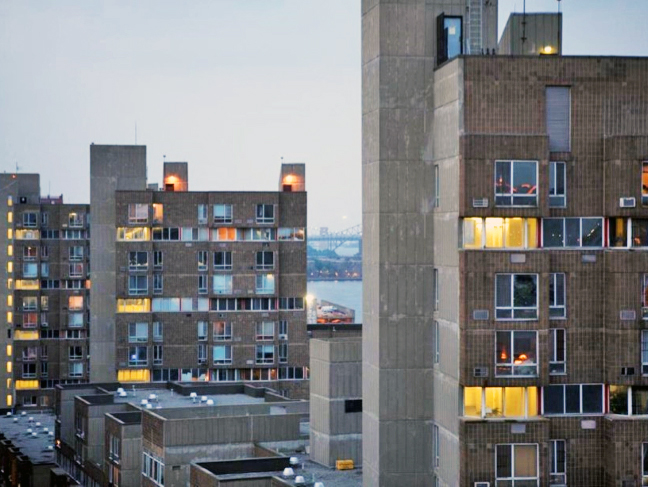 Soon after the acquisition, UA embarked on a capital plan coordinated with a comprehensive energy-efficiency scope of work. New windows were installed throughout the complex. So were lights, ventilation-fan controls, ENERGY STAR refrigerators, and low-flow water fixtures. These measures were intended to meet NYSERDA’s program requirement of 15 percent energy savings for the whole building.
Soon after the acquisition, UA embarked on a capital plan coordinated with a comprehensive energy-efficiency scope of work. New windows were installed throughout the complex. So were lights, ventilation-fan controls, ENERGY STAR refrigerators, and low-flow water fixtures. These measures were intended to meet NYSERDA’s program requirement of 15 percent energy savings for the whole building.
Sub-meters were also installed to enable a third-party company to bill residents for their electricity consumption, based on permission from the New York Public Service Commission (NYPSC). Despite prior approvals, the NYPSC reversed its decision and prohibited the complex from using the sub-meters to bill residents after the installation of the sub-meters had been completed at a cost of over $1 million.
As a result, UA found itself with reduced but still unsustainably-high operating costs. Moreover, UA had already depleted available capital resources by implementing a comprehensive list of energy-efficiency upgrades.
The project’s most lasting legacy may be its demonstration of the business case for this type of work to hard-nosed investors.
To address both of these challenges, UA set out to develop an innovative scope of work that would allow deeper savings. It also created a new subsidiary, UG, to act as an energy services company (ESCO) to finance and implement the scope of work at this building and eventually others. UG then implemented a new scope of work at Roosevelt Landings in 2012-2013.
Like many other buildings in New York City, Roosevelt Landings has been impacted by climate change. It suffered temporary power outages that affected a third of its apartments due to flooding of a subterranean electrical room during Hurricane Sandy.
Combined heat and power (CHP) technology can help to address the power outages hurricanes can create. The building’s new CHP system will have a dramatic positive impact on people's lives during emergencies. The CHP and boiler system is strategically located on the 21st floor of the property's tallest building to support building resiliency by providing residents with hot water when the electric grid is down. In addition, electricity can be maintained in the generating room during power outages, creating an emergency management command center with additional potential capabilities.
The use of wireless thermostats and an energy-management system was a direct response to the NYPSC’s rejection of UA’s attempt to sub-meter residents to reduce costs and encourage rational behavior. The new control system now allows UA to manage the heat centrally, increasing efficiency dramatically.
Designing the Scope of the Retrofit
The retrofit’s scope included CHP, domestic hot water load reduction, heater replacement, wireless apartment thermostats, energy-management systems, programmable thermostats, corridor ventilation, resident education, floor-slab insulation, blower-door testing, and air-sealing.
Heater Replacement: UG replaced older-model baseboard heaters with new heaters that provide better performance in every apartment due to faster heating-coil materials and modern technology.

CHP and Domestic Hot Water Load Reduction: A two-part strategy was executed to reduce the domestic hot water requirements as much as possible prior to the installation of an appropriately-sized CHP system to address the remaining load. Low-flow aerators and showerheads were installed as part of the 2008 scope of work.
A condensing domestic hot water boiler plant installed in 2013 further reduced the energy load by drastically cutting standby losses. UG installed five 1.35-million-BTU water heaters that operate at 95-percent fuel efficiency. The heaters replaced four outdated Scotch Marine steam boilers that were 65-percent-efficient at best.
 While construction delays and technical challenges delayed deployment of the CHP system, the system is now operating at 100-percent capacity. UG installed three 100-kW CHP modules that together have the capacity to generate 300 kW of electricity and 2.1 million BTU/hr of domestic hot water.
While construction delays and technical challenges delayed deployment of the CHP system, the system is now operating at 100-percent capacity. UG installed three 100-kW CHP modules that together have the capacity to generate 300 kW of electricity and 2.1 million BTU/hr of domestic hot water.
The CHP system creates 15 percent of the building’s electricity onsite and heats 40 percent of its domestic hot water. This system is also equipped with black start capabilities to function as an emergency generator supplying critical building systems – such as house pumps for providing water to all apartments – during grid outages.
Wireless Apartment Thermostats and Energy-Management Systems: The integration of resident-facing off-the-shelf digital thermostats with a wireless mesh network has been done before, though the scale of this installation is somewhat exceptional. Proving the savings at this scale is helping to catalyze the market for this retrofit.
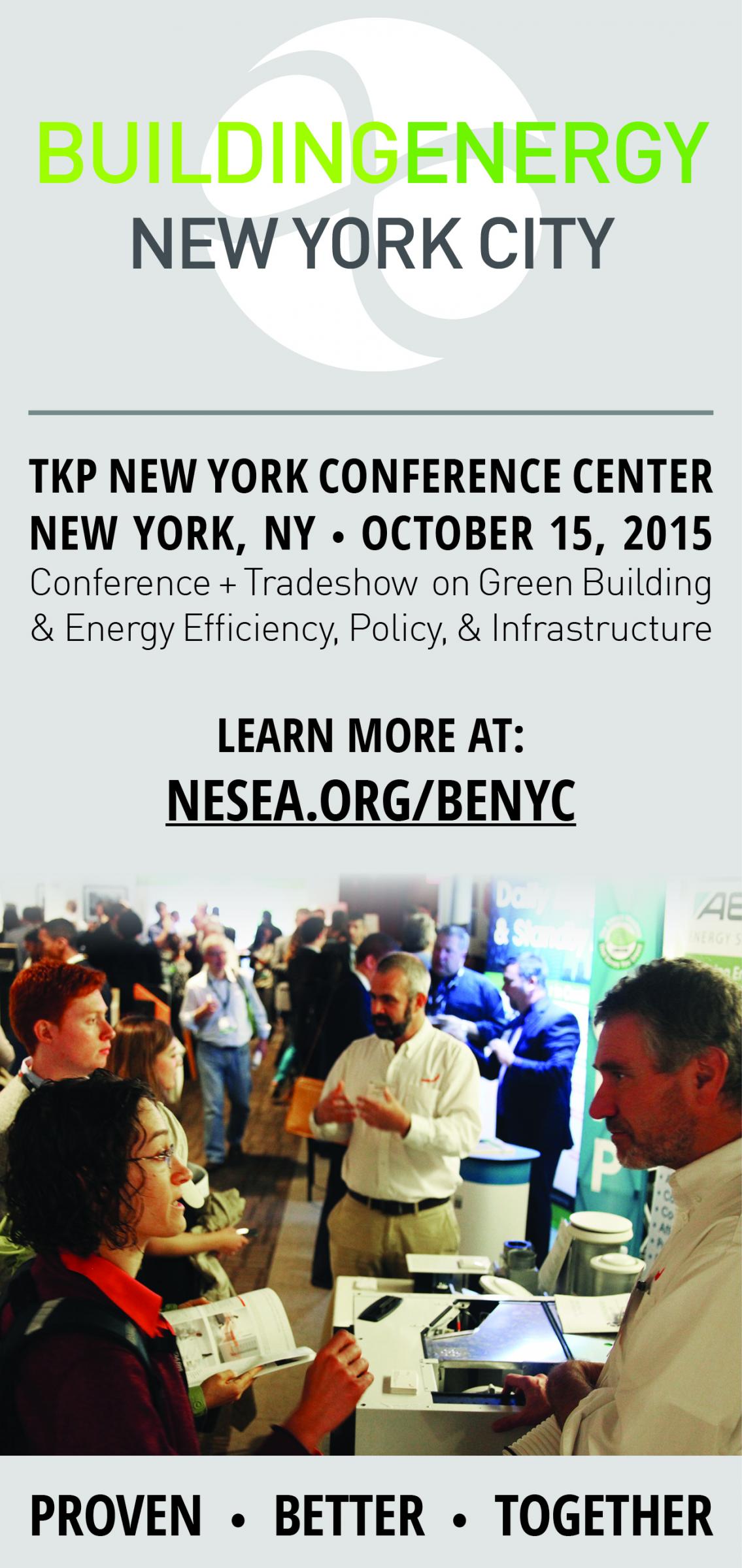 One practical but also innovative aspect of the work was the incorporation of window sensors to reduce heat output in rooms with open windows. The wireless backbone and control infrastructure in place allowed magnetic sensors to be installed to sense whether windows are open at minimal extra cost. No system is completely tamper-proof, but the window-open alarms provide management information for a sprawling complex. They also send a strong signal to residents about the significance of open windows. This can be the first step in spurring behavioral change.
One practical but also innovative aspect of the work was the incorporation of window sensors to reduce heat output in rooms with open windows. The wireless backbone and control infrastructure in place allowed magnetic sensors to be installed to sense whether windows are open at minimal extra cost. No system is completely tamper-proof, but the window-open alarms provide management information for a sprawling complex. They also send a strong signal to residents about the significance of open windows. This can be the first step in spurring behavioral change.
Installation of Programmable Thermostats: Dials and buttons on old baseboard heaters were replaced with wall-mounted programmable thermostats. Each thermostat sends a wireless signal to a paired controller on each baseboard heater. Residents are able to select target temperatures.
Corridor Ventilation: The original design limited the number of public corridors in the complex compared to a traditional double-loaded corridor layout. But where there were corridors, they were configured with slider windows running nearly their entire lengths. The design was based on natural ventilation with operable windows to meet the fresh air requirements for the 40 public corridors.
This passive design strategy is ideal for the spring, summer and fall. But during the heating season, this decision resulted in severe operational waste. Nearly every time SWA visited the site during the winter, the team observed one partially-open window in most public corridors. During winter, providing ventilation as energy-efficiently as possible requires a controllable mechanical system to ensure sufficient-but-not-excessive airflow – as the saying goes, “Build tight but ventilate right.”
The team installed new code-compliant mechanical ventilation systems via wall penetrations in all 40 public corridors. The crew also installed window locks on all corridor slider windows. When the mechanical ventilation is operating, windows are locked during the winter. In the spring, summer and fall, windows are unlocked and mechanical ventilation is disabled. This new scheme was filed with the New York City Department of Buildings and reviewed by the New York City Fire Department. In a traditional double-loaded corridor, there are usually no windows. The current scheme results in enhanced year-round performance compared to most other similar buildings.
 Apartment Air-Sealing and Ventilation: The air-sealing designed and installed by ABS provided operating cost benefits to the owner and comfort benefits to residents. There was also a synergy between these envelope upgrades and the new controls.
Apartment Air-Sealing and Ventilation: The air-sealing designed and installed by ABS provided operating cost benefits to the owner and comfort benefits to residents. There was also a synergy between these envelope upgrades and the new controls.
With insulation improvements, spaces can be more comfortable even at lower temperatures when they are not drafty. The gap between the deteriorated bottom of the sheetrock and the concrete-slab floor behind the electric baseboards, which created an extensive air-barrier defect throughout the property, was air-sealed.
Staff tightened the building envelope by air-sealing apartments to eliminate cold air infiltration and drafts during the heating season. This work also enhanced resident comfort during the cooling season by preventing warm, humid air from entering air-conditioned apartments. They performed six types of work in each apartment:
1. plugging the holes behind the heaters and along the exterior walls that allowed drafts into the building
2. caulking the windows where leaks were evident
3. installing draft-blocking gaskets in exterior-wall electrical outlets
4. caulking beneath the sills of the outside windows
5. sealing holes near sink pipes that allowed drafts and pests to enter apartments
6. installing plugs over air conditioners and sleeves
The crews also cleaned and retrofitted the ventilation register covers and installed orifices in resident kitchens and bathrooms. The metal interiors of the ventilation ducts were brushed and wiped clean. The new orifice plates were installed to regulate and distribute ventilation airflow more evenly among apartments.
Common Area Air-Sealing: In addition to working in apartments, ABS air-sealed common areas, including elevator machine rooms, stairwells, and HVAC rooms. Through-wall air-supply fans with filters were installed in each corridor. They operate when the windows are locked to meet New York’s building code and ASHRAE’s code guidelines. These measures have eliminated the wind-tunnel effect that many residents experienced in the halls during cold months. They also keep cold air out of the hallways and apartments.
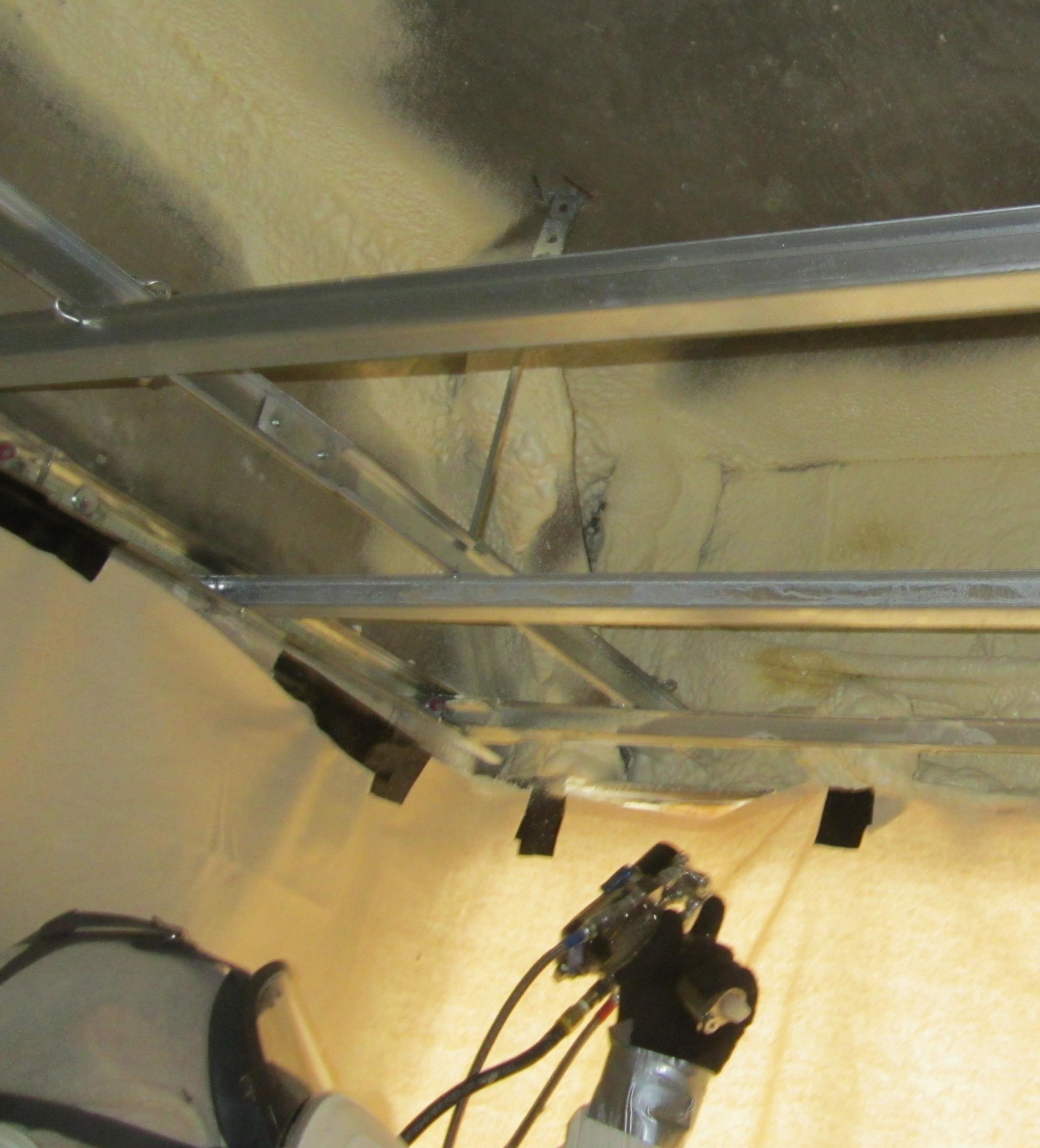
The complex includes seven banks of elevators. Prior to the retrofit, the tops of the shafts were vented directly to the outside per code, resulting in thousands of cubic feet per minute of conditioned air escaping.
SWA’s measurements of airflow escaping from elevator shafts before and after the retrofit were the impetus for “Spending through the Roof,” a study published by Urban Green Council. This study has drawn significant attention to the issue of elevator-shaft venting. The New York Times covered the study. The study quantified the $11 million in annual savings possible by addressing this leakage in New York City alone.
Floor Slab Insulation: ABS installed high-density spray foam directly below the concrete floor slabs and at the wall penetrations of apartments that protrude over walkways and sidewalk arcades. This has eliminated the key source of cold floors in these apartments and blocked cold air from leaking into the building.
In addition, fabricating ducts and sealing connections proved to be successful strategies. Initially, the exhaust ventilation connections in the building were not sealed to the primary shaft. Some had no ducts to connect the grilles to the shafts. Fabricating ducts and sealing these connections eliminated quite a bit of leakage.
The ventilation orifices further restricted and balanced airflow from the units. While installing polyurethane spray foam (SPF) on the underside of the cantilevered spaces, the team sealed a number of large penetrations as well by extending the foam down the sidewall towards the drop-in ceiling panel level.
Building Operator and Resident Education: To support UG’s efforts, UA put its key maintenance and management staff through Building Performance Institute’s Building Operator Certification course. Further, UA provides residents with helpful materials and education seminars on how to reduce their own households’ energy consumption.
Blower-Door Testing: ABS provided design assistance to the engineering consultant, SWA, by conducting a building-envelope evaluation in accordance with ASHRAE standards.
Duct-blasters in blower-door frames were set up in a number of apartments. Their main use was to provide the pressure differential necessary for infrared, smoke-tracer, and hot-wire anemometer testing to identify leakage sites. Common areas were inspected with similar technologies using the buildings’ natural stack pressures as the driving force to identify leakage locations. A comprehensive report was submitted and eventually became part of a larger retrofit.
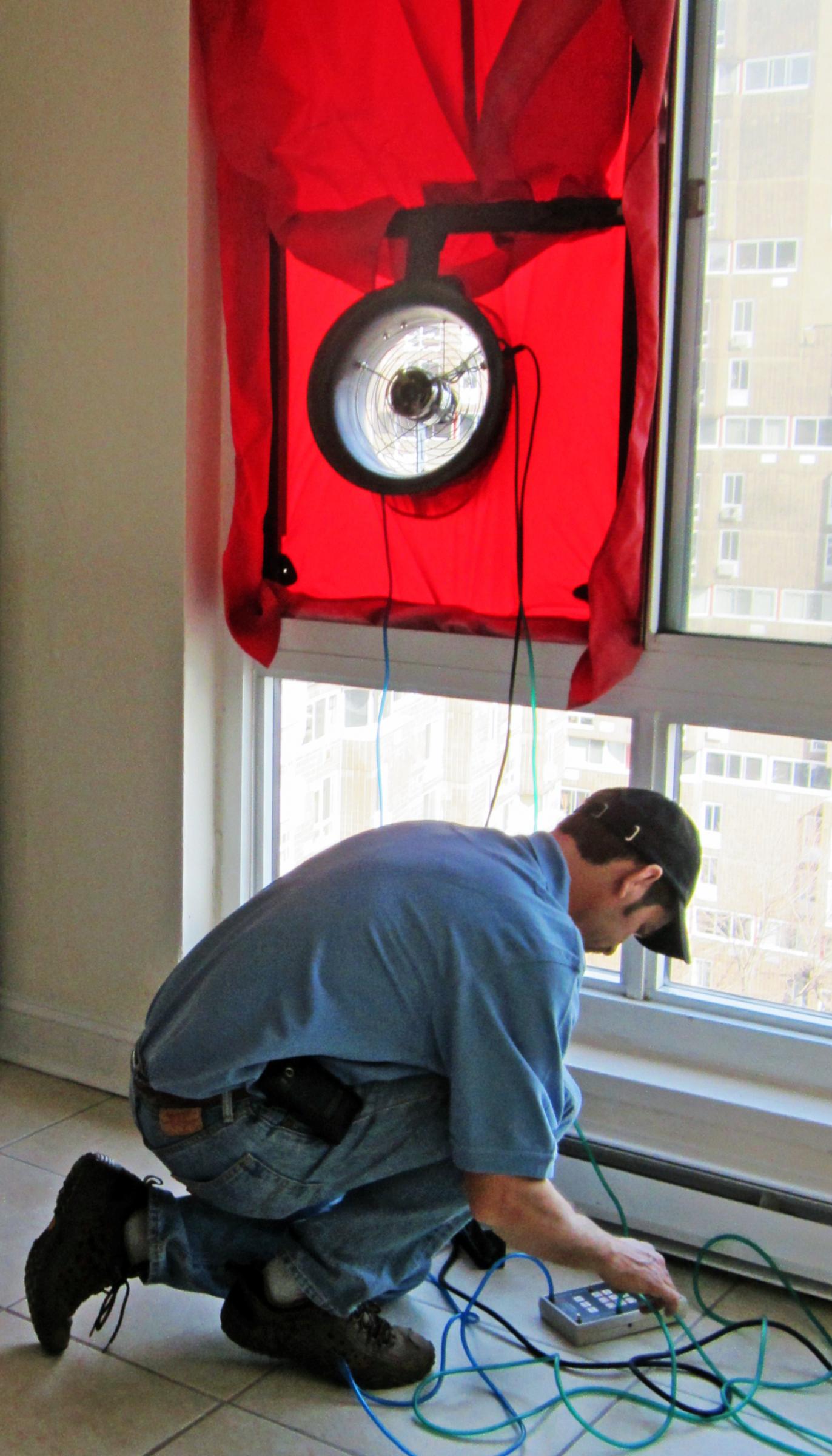
SWA had previously investigated the application of SPF to the underside of cantilevered spaces at this location. The crew also had specific treatments it was trying to implement in elevator-control rooms. The team was concerned about ventilation issues in the kitchen and bath areas. The crew decided to install orifices in the exhaust-ventilation duct grilles in the units to regulate airflow throughout the building.
Looking toward the Future
An additional positive development has emerged from this solution. The infrastructure put in place for these new controls will be a platform for a planned future project to sub-meter residents only for the apartment-lighting and plug-load portions of their consumption.
Urban American plans to replicate this proven scope of work on a group of other large postwar master-metered and electrically-heated complexes.
With this new system, residents will be accountable for the portions of their consumption that they control completely. This will include their use of energy-efficient lights, appliances or outlets, but not their use of electric heaters. Metering of heaters has historically been the major cause of resistance to sub-metering in these types of buildings.
UA will continue to manage heating limits centrally and will always have an incentive to pursue further envelope upgrades to reduce heating requirements. The project team anticipates an additional 10-percent reduction in whole-building source energy use intensity as a result of this future project.
These resulting benefits will be realized nearly a decade after sub-metering was first proposed. While the process has been circuitous, politicized, and at times contentious, the final approach represents a thoughtful model for other electrically-heated buildings.
UA plans to replicate this proven scope of work on a group of other large postwar master-metered and electrically-heated complexes.
With other owners, SWA is also engaged in a pipeline of two million square feet of electrically-heated complexes scheduled to start construction in 2015. These complexes have very similar scopes of work to the Roosevelt Landings project. Finally, SWA, with a grant from the Natural Resources Defense Council, is currently benchmarking the Mitchell Lama portfolio, which is made up of 180 large postwar complexes across New York state.
Applying Lessons Learned
The vast majority of the upgrade work required access to apartment spaces. The coordination of multiple visits by electricians and air-sealing laborers across 1,003 apartments was a challenge met by a full-time onsite project manager overseeing all workers and coordinating resident engagement and communications.
One lesson the team learned from this project is that ensuring reliable access to apartments can save a great deal of time and effort.
At a cost of over $1 million, the extensive whole-building air sealing scope of work was the largest air-sealing retrofit project in New York City. Because the deep and site-specific air-sealing scope did not fit into the simple prescriptive rebate-application forms, the project team spent extensive time documenting assumptions and calculations to successfully support an application for a $300,000 incentive from Con Edison.
Finally, the corridor-ventilation upgrade was nearly halted at an early stage as a result of a myth that had been perpetuated onsite for decades that the New York City Fire Department wouldn’t permit the corridor windows to be locked. In a conference call, the team found out that the fire department did have a concern about the corridor windows: to prevent falls, it simply wanted to make sure the windows could not be fully opened. Sometimes it pays to ask a question.
Hear more about this project and from these expert professionals at:
Our Mission
NESEA advances sustainability practices in the built environment by cultivating a cross-disciplinary community where practitioners are encouraged to share, collaborate and learn.







Add comment